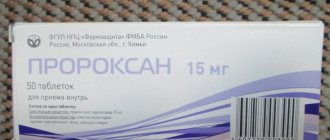Write a review
Reviews: 0
Manufacturers: Gedeon Richter (Hungary)
Active ingredients
- Hydrochlorothiazide
- Losartan
Disease class
- Essential [primary] hypertension
- Secondary hypertension
- Heart failure, unspecified
Clinical and pharmacological group
- Antihypertensive drugs
Pharmacological action
- Antihypertensive
Pharmacological group
- Angiotensin II receptor antagonists (AT1 subtype)
- Angiotensin II receptor antagonists (AT1 subtype) in combinations
Oral tablets Losartan-N Richter (Lazartan-N Richter)
Instructions for medical use of the drug
Description of pharmacological action
The active substances have an additive antihypertensive effect, reducing blood pressure to a greater extent than each of the components individually. Hydrochlorothiazide reduces the reabsorption of sodium and chlorine ions (to a lesser extent, potassium and bicarbonates) in the proximal tubules of the kidneys, increases the excretion of magnesium ions, and reduces the excretion of calcium ions and uric acid. Inhibits the reactivity of the vascular wall in relation to the vasoconstrictive effects of mediators due to a decrease in the concentration of sodium ions in the cytoplasm of vascular myocytes, reduces blood volume, and lowers blood pressure. Losartan and its active metabolite (10–40 times more active than the parent substance), due to the suppression of the effects of aldosterone, help reduce the loss of potassium caused by taking the diuretic. Losartan blocks angiotensin II receptors (AT1 subtype) in various tissues, including the adrenal cortex, brain, kidneys, liver, vascular smooth muscle, heart and prevents the development of the effects of angiotensin II. Reduces arterial vasoconstriction, peripheral vascular resistance, pressure in the pulmonary circulation, reduces wedge pressure in the pulmonary vessels, inhibits the release of aldosterone, and prevents sodium and water retention in the body. Increases exercise tolerance in patients with heart failure.
Indications for use
Arterial hypertension. Reducing the risk of cardiovascular morbidity and mortality in patients with arterial hypertension and left ventricular hypertrophy.
Release form
film-coated tablets 50 mg +12.5 mg; contour packaging 10 cardboard pack 3; film-coated tablets 100 mg + 25 mg; contour packaging 10 cardboard pack 3; film-coated tablets 100 mg + 12.5 mg; contour packaging 10 cardboard pack 3; film-coated tablets 100 mg + 12.5 mg; contour packaging 10 cardboard pack 3;
Pharmacodynamics
The active substances have an additive antihypertensive effect, reducing blood pressure to a greater extent than each of the components individually. Hydrochlorothiazide reduces the reabsorption of sodium and chlorine ions (to a lesser extent, potassium and bicarbonates) in the proximal tubules of the kidneys, increases the excretion of magnesium ions, and reduces the excretion of calcium ions and uric acid. Inhibits the reactivity of the vascular wall in relation to the vasoconstrictive effects of mediators due to a decrease in the concentration of sodium ions in the cytoplasm of vascular myocytes, reduces blood volume, and lowers blood pressure. Losartan and its active metabolite (10–40 times more active than the parent substance), due to the suppression of the effects of aldosterone, help reduce the loss of potassium caused by taking the diuretic. Losartan blocks angiotensin II receptors (AT1 subtype) in various tissues, including the adrenal cortex, brain, kidneys, liver, vascular smooth muscle, heart and prevents the development of the effects of angiotensin II. Reduces arterial vasoconstriction, peripheral vascular resistance, pressure in the pulmonary circulation, reduces wedge pressure in the pulmonary vessels, inhibits the release of aldosterone, and prevents sodium and water retention in the body. Increases exercise tolerance in patients with heart failure.
Use during pregnancy
Taking drugs that directly act on the RAAS in the second and third trimester of pregnancy can lead to fetal death. If pregnancy is established, the combination should be discontinued as soon as possible. For relatively healthy pregnant women, the use of diuretics is usually not recommended due to the risk of jaundice in the fetus and newborn and thrombocytopenia in the mother. Category of action on the fetus according to the FDA is C (I trimester). FDA category of effect on the fetus is D (II and III trimesters).
Contraindications for use
Hypersensitivity, anuria, hypovolemia (including against the background of high doses of diuretics), liver and/or renal failure, pregnancy, lactation.
Side effects
According to the State Register of Medicines, vol. II, 2004, the following side effects were observed in patients receiving the combination of losartan/hydrochlorothiazide: decreased blood pressure, dizziness, allergic reactions: angioedema (swelling of the face, lips and/or tongue), hyperkalemia, increased activity of liver transaminases. According to Physicians Desk Reference, 2005: no adverse events specific to this combination were observed in clinical studies with losartan/hydrochlorothiazide. Adverse effects were limited to those reported with losartan and/or hydrochlorothiazide alone. The total incidence of adverse events when taking this combination was comparable to that when using placebo. In general, treatment with losartan/hydrochlorothiazide was well tolerated. In most cases, adverse events were moderate, transient in nature and did not require discontinuation of therapy. In controlled clinical trials, discontinuation of therapy due to the development of adverse events was observed in 2.8% of cases in patients receiving losartan/hydrochlorothiazide and in 2.3% of cases in the placebo group. In double-blind controlled clinical trials, the following side effects were observed in ≥1% of patients and at a frequency greater than placebo, regardless of causal relationship to the drug (percentage in the placebo group is indicated in parentheses): abdominal pain 1.2 (0.6)% , swelling/edema 1.3 (1.2)%, palpitations 1.4 (0.0)%, back pain 2.1 (0.6)%, dizziness 5.7 (2.9)%, cough 2.6 (2.3)%, sinusitis 1.2 (0.6)%, upper respiratory tract infection 6.1 (4.6)%, skin rash 1.4 (0.0)%. Side effects noted in ≥1% of patients, but the frequency of which was the same or even greater in the group of patients with essential hypertension receiving placebo, were asthenia/fatigue, diarrhea, nausea, headache, bronchitis, pharyngitis. Side effects were observed with equal frequency in male and female patients, with a higher frequency in elderly and black patients (both in the control group and in the placebo group). Patients who had previously taken losartan and had a history of hypersensitivity to acetylsalicylic acid or penicillin were excluded from the study due to indications of swelling of the lips, eyelids and rash, considered to be the development of angioedema.
Directions for use and doses
Inside, 1 tablet. Once a day, daily. The maximum dose is 2 tablets/day. The maximum hypotensive effect occurs within 3 weeks after the start of treatment.
Overdose
Symptoms: losartan - decreased blood pressure, tachycardia, bradycardia (as a result of vagal stimulation). Hydrochlorothiazide - loss of electrolytes (hypokalemia, hypochloremia, hyponatremia); dehydration (excessive diuresis). Treatment: gastric lavage (if the drug has been taken recently), if necessary, correction of water and electrolyte disturbances, symptomatic and supportive therapy. Losartan and its active metabolites are not removed by hemodialysis.
Interactions with other drugs
When hydrochlorothiazide is prescribed simultaneously with ethanol, barbiturates, and opioid analgesics, the risk of developing orthostatic hypotension increases; with oral hypoglycemic drugs and insulin, dose adjustment of hypoglycemic drugs may be required. With other antihypertensive drugs - an additive effect, with cholestyramine and colestipol - impaired absorption of hydrochlorothiazide. A single dose of cholestyramine or colestipol can reduce the absorption of hydrochlorothiazide from the gastrointestinal tract by 85% and 43%, respectively. When administered simultaneously with glucocorticoids, ACTH, it is possible to increase the loss of electrolytes and worsen hypokalemia; with pressor amines (norepinephrine, epinephrine), a slight decrease in the effect of pressor amines is possible, which does not interfere with their use; with non-depolarizing muscle relaxants (tubocurarine) - an increase in their effect, with NSAIDs - a possible decrease in diuretic, natriuretic, hypotensive effect. Do not use simultaneously with lithium preparations, because diuretics reduce the renal clearance of lithium and increase the risk of intoxication.
Precautions for use
Possible combined use with other antihypertensive drugs. There is no need to select a dose for elderly patients. May increase plasma urea and creatinine concentrations in patients with bilateral renal artery stenosis or renal artery stenosis of a solitary kidney. Hydrochlorothiazide can increase hypotension and water-electrolyte imbalance (decrease in blood volume, hyponatremia, hypochloremic alkalosis, hypomagnesemia, hypokalemia), impair glucose tolerance, reduce the excretion of Ca2+ in the urine and cause a transient increase in the concentration of Ca2+ in plasma, increase the concentration of cholesterol and triglycerides, provoke the occurrence of hyperuricemia and/or gout.
Storage conditions
List B.: In a dry place, at a temperature not exceeding 30 °C.
Best before date
24 months
ATX classification:
C Cardiovascular system
C09 Drugs affecting the renin-angiotensin system
C09D Angiotensin II antagonists in combination with other drugs
C09DA Angiotensin II antagonists in combination with diuretics
C09DA01 Losartan in combination with diuretics
Compound
The composition of this drug includes the active substance - losartan potassium in the amount of 25 mg / 50 mg / 100 mg, depending on the form of release of the drug.
The following are used as excipients:
- lactose monohydrate;
- microcrystalline cellulose;
- pregelatinized starch;
- magnesium stearate in quantity.
The shell includes:
- polyvinyl alcohol;
- titanium dioxide;
- macrogol;
- talc.
Similar drugs:
- Berlipril Oral tablets
- Moxogamma Oral tablets
- Diacordin 60 Oral tablets
- Captopril-AKOS Oral tablets
- Moxonitex Oral tablets
- Captopril Oral tablets
- Adelphane-Esidrex Tablets
- Valz Oral tablets
- Valz H Oral tablets
- Moxonidine Oral tablets
** The Drug Directory is intended for informational purposes only. For more complete information, please refer to the manufacturer's instructions. Do not self-medicate; Before starting to use the drug Losartan-N Richter, you should consult a doctor. EUROLAB is not responsible for the consequences caused by the use of information posted on the portal. Any information on the site does not replace medical advice and cannot serve as a guarantee of the positive effect of the drug.
Are you interested in the drug Losartan-N Richter? Do you want to know more detailed information or do you need a doctor's examination? Or do you need an inspection? You can make an appointment with a doctor - the Euro lab is always at your service! The best doctors will examine you, advise you, provide the necessary assistance and make a diagnosis. You can also call a doctor at home . Euro lab clinic is open for you around the clock.
** Attention! The information presented in this medication guide is intended for medical professionals and should not be used as a basis for self-medication. The description of the drug Losartan-N Richter is provided for informational purposes and is not intended for prescribing treatment without the participation of a doctor. Patients need to consult a specialist!
If you are interested in any other drugs and medications, their descriptions and instructions for use, information about the composition and form of release, indications for use and side effects, methods of use, prices and reviews of drugs, or you have any other questions and suggestions - write to us, we will definitely try to help you.
Pharmacodynamics and Pharmacokinetics
This drug has a hypotensive effect immediately after the first oral administration. The effect of the drug is expressed in a decrease in systolic and diastolic blood pressure, which is achieved at most 6 hours after administration. After a day, the effect of the drug decreases. A stable hypotensive effect is observed after 3-6 weeks of taking Losartan.
In people suffering from arterial hypertension, this drug reduces proteinuria, excretion of albumin and immunoglobulin G. In addition, the active substance helps stabilize the urea content in the blood plasma without affecting the content of norepinephrine in the blood plasma.
Losartan is characterized by excellent absorption from the gastrointestinal tract. Of no less importance is the ability of the active substance to be metabolized during a single passage through the liver by carboxylation with the participation of the CYP2C9 isoenzyme, which forms an active metabolite.
Systemic bioavailability of the active substance is approximately 33%. After approximately 60 minutes, the maximum concentration of the active substance in the blood serum is reached. The bioavailability of Losartan is not affected by food intake.
The degree of penetration of Losartan through the blood-brain barrier is minimal. Almost 99% of the substance binds to albumin and other blood plasma proteins.
Plasma clearance is approximately 600 ml/min and 50 ml/min. Renal clearance is approximately 74 ml/min and 26 ml/min. After taking the drug, approximately 4% of the dose taken is excreted through the kidneys unchanged and approximately 6% is excreted through the kidneys in the form of an active metabolite.
Basically, the active substance of this drug is excreted from the body through the kidneys and intestines.
Contraindications
Losartan-NAN is contraindicated for use in children under 6 years of age
Unlike many antihypertensive drugs, Losartan-NAN has a small list of contraindications for use. According to the official instructions for the medication, its use is prohibited:
- people with hypersensitivity to the components of the product
- pregnant and lactating women
- patients with serious liver pathologies
- persons treated with Aliskiren due to diabetes mellitus
- children under 6 years old
The drug should be taken with extreme caution in patients:
- aged 6 to 18 years
- suffering from serious forms of arrhythmic disorders and heart failure
- with problems of kidney and liver pathologies
- having insufficient blood volume in the body (for example, with recent blood loss)
- with impaired water-electrolytic functions of the body
- using potassium-containing diuretics for the treatment of kidney diseases
In other clinical cases, Losartan-NAN is allowed to be taken by all hypertensive patients according to appropriate doctor’s indications. Violation of the dosages recommended by the doctor or the norms for taking the drug reflected in the instructions is not allowed.
Losartan or Amlodipine
Manufacturer: Pranafarm, Biokhimik, Veropharm, Teva, etc., Russia
Release form: tablets
Active ingredient: amlodipine
Synonyms: Amlotop, Normodipin, Kalchek, etc.
Amlodipine is an antihypertensive drug from the group of slow calcium channel blockers. In addition to lowering blood pressure, the medicine helps to improve well-being during physical activity and angina pectoris.
Amlodipine and Losartan are often prescribed together when monotherapy is ineffective. The side effects of the analogue should be taken into account - allergic reactions, swelling.
There is another combination of Amlodipine and Valsartan - the drug Vamloset.
The pressing question is what to replace Losartan with. The medication is a prescription antihypertensive drug. According to the rules for writing a prescription, the patient can choose any drug with the international name Losartan that is affordable and suitable in terms of cost and quality. These are Lozap, Lorista and others.
Indications for use
Indications for the use of Losartan are as follows:
- arterial hypertension (a condition of the body when blood pressure rises above 140 mm Hg);
- chronic heart failure (a pathological condition in which the activity of the cardiovascular system does not provide oxygen to the body, first during physical activity and then at rest);
- the risk of developing diseases of the cardiovascular system, in particular stroke;
- diabetic nephropathy (a term that combines a complex of lesions of the arteries, arterioles, tubules and glomeruli of the kidneys, which develop as a result of metabolic disorders in the kidney tissues).
Use during pregnancy, lactation and treatment of children
The use of Losartan-NAN for pregnant women is possible only as prescribed by a doctor.
For a whole list of patient groups, the use of Losartan-NAN is permitted for special indications by specialists. These fully include:
- Pregnant and lactating women who are completely prohibited from taking antihypertensive drugs without a specialized prescription from a doctor. Doctors, in turn, also rarely resort to prescribing Losartan-NAN to pregnant and lactating patients. Typically, this remedy is used if not taking the drug carries greater risks than organizing antihypertensive therapy.
- Children aged 6 to 18 years (children under 6 years old are not allowed to take Losartan-NAN at all). For this group of hypertensive patients, the drug requires administration with extreme caution. There are no significant prohibitions on its use, however, due to the young age of patients, doctors prescribe them dosages halved.
- Elderly people over 75 years old. As is the case with children, this group of patients requires special caution in terms of prescribing Losartan-NAN. Since antihypertensive drugs affect the human heart and blood vessels, their weak tone in older people may be impaired if they are actively used. Taking this into account, doctors also reduce the dosage of the drug by half.
As for patients suffering from certain forms of internal pathologies, the prescription of Losartan-NAN for them is carried out exclusively by a professional doctor.
In such situations, it is important to take into account the individual characteristics of a particular clinical case, otherwise the optimal selection of dosages and course of therapy will simply be impossible.



